Physical Address
304 North Cardinal St.
Dorchester Center, MA 02124
Physical Address
304 North Cardinal St.
Dorchester Center, MA 02124

Transform your backyard into a serene sanctuary with these 23 wellness-focused ideas. Discover how to create a luxury oasis on a budget through thoughtful design.
Picture this: The door whispers shut behind you, leaving the noise of the day behind. You step out into your own backyard, but it feels different. It feels like an exhale. The air is scented with lavender and damp earth, a soft golden light spills from a canopy of tiny stars overhead, and the sound of gently trickling water draws you toward a comfortable lounge chair. This isn’t a five-star resort. This is your home.
You know, people always ask me how they can create that transportive, spa-like feeling without a massive budget. They think luxury is about spending a fortune on marble and infinity pools. But I’ve learned that true luxury, the kind that actually sinks into your bones and unwinds your spirit, is about intention. It’s about creating a space that nurtures you. It’s about resourcefulness, not outrageous expense.
So, let me tell you the real story. Here are 23 ways to transform your backyard into a personal sanctuary, and the secret is that most of them are surprisingly gentle on your wallet.
Before a single plant goes in the ground, we have to set the stage. This isn’t about pouring concrete; it’s about pouring intention into the space. A truly rejuvenating sanctuary is built on a foundation of thoughtful design that anticipates your need for peace, connection, and restoration. It’s where the magic really begins.
Forget just having a “backyard.” We’re going to create distinct outdoor rooms, each with its own energy and purpose. This is how you make even a small space feel expansive and deeply personal. One area might be for quiet contemplation, with a single comfortable chair. Another could be a ‘conversation pit’ for connecting with loved ones. It’s about designing for how you want to feel.
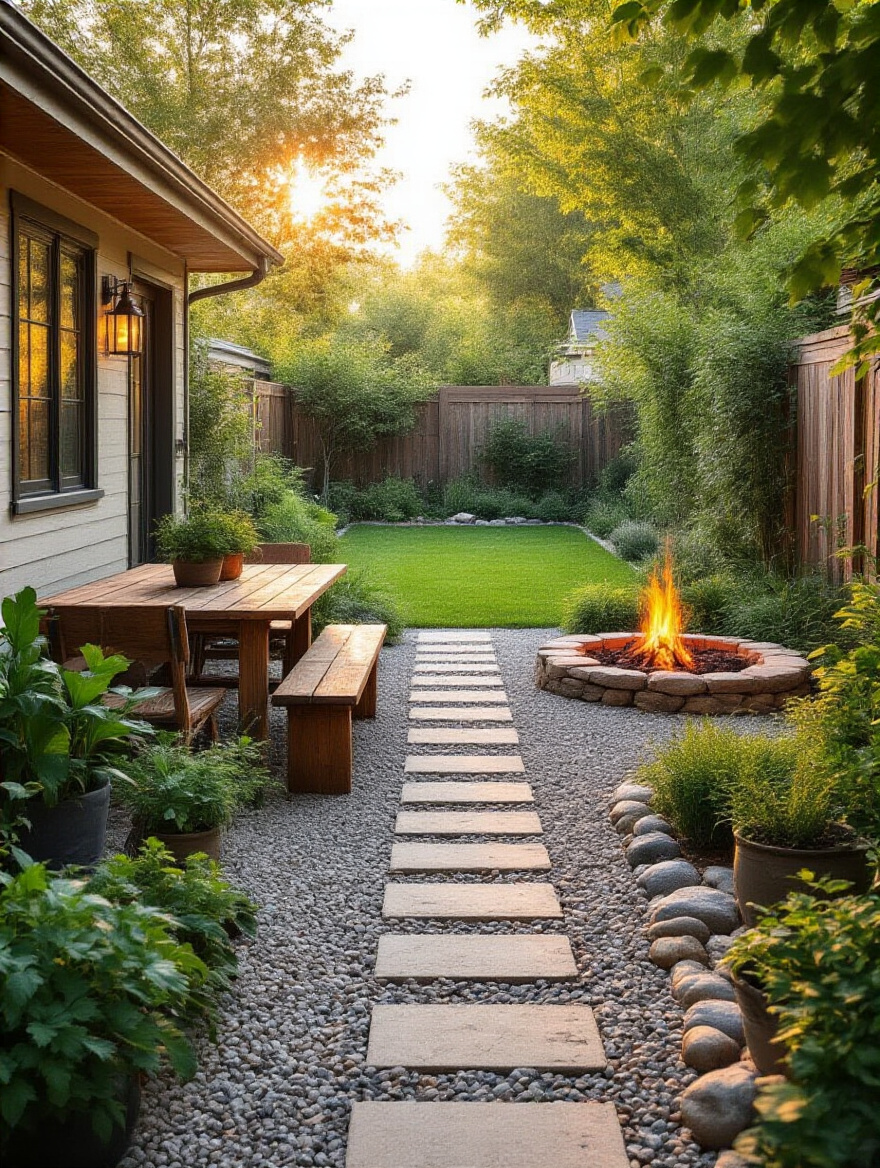
The mistake people make is thinking they need walls or expensive pergolas to do this. That’s noise. What really matters is defining the space with subtle cues. Use a simple outdoor rug to anchor a seating area. Hang a canopy of string lights to create a ceiling. A thoughtful grouping of oversized pots can create a sense of enclosure for a reading nook. I learned this the hard way on an early project where we overbuilt—the client felt boxed in. Now, I know the most luxurious boundaries are often the ones you can see right through.
This intentional separation prepares your mind to relax as you move through the space, and once you have a vision for each ‘room,’ you’ll need a clean slate to bring it to life.
Before you can introduce beautiful, calming new life into your garden, you must first create a peaceful foundation. This means gently but firmly dealing with weeds. People see this as a chore, but I see it as an essential act of clearing—like smudging a room to clear its energy. If you skip this, you’re setting yourself up for a constant battle that drains your energy and your budget.
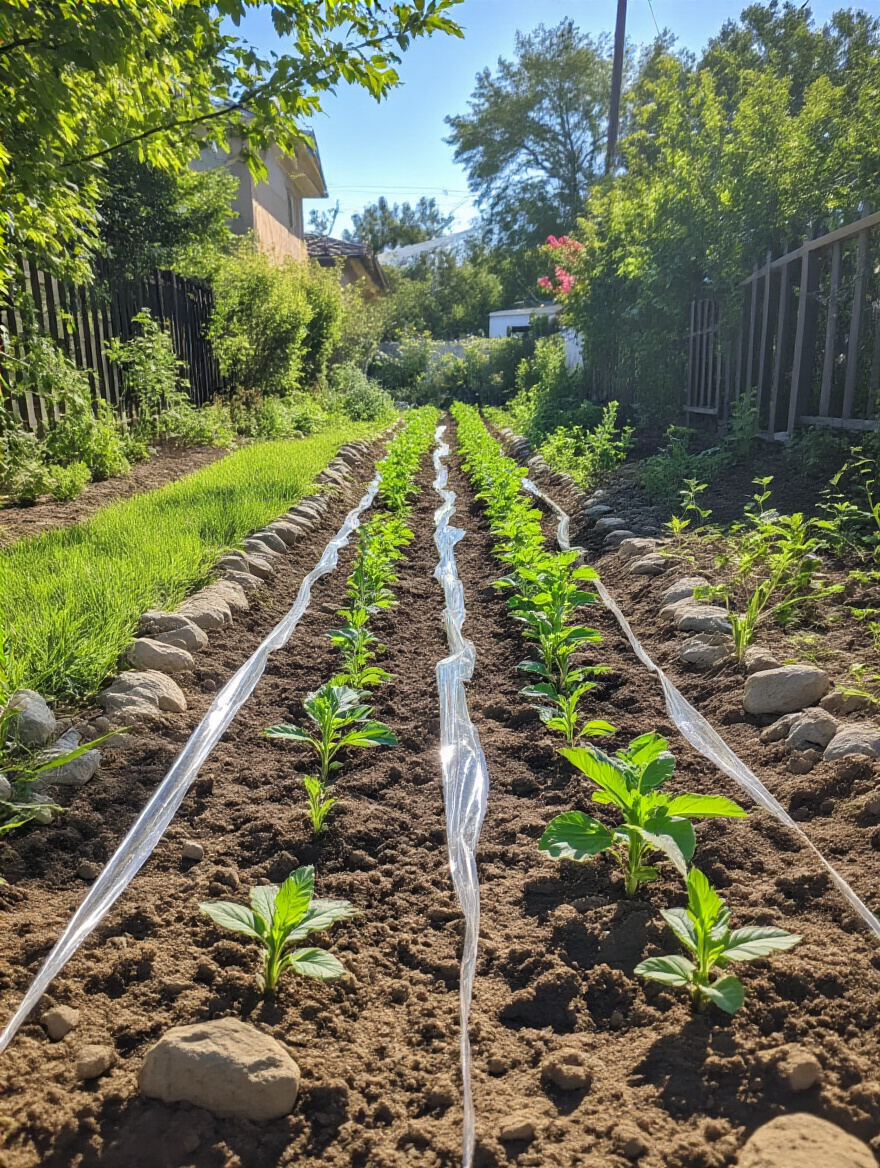
A lot of advice will send you straight to harsh chemical sprays. That’s just bringing a stressed, aggressive energy into the very sanctuary you’re trying to create. The real, lasting solution is sheet mulching, sometimes called lasagna gardening. You lay down cardboard to block the light, then layer it with organic materials like leaves and grass clippings. It sounds simple, but it’s profoundly effective. It doesn’t just kill the weeds; it breaks down and builds incredibly rich, healthy soil for whatever you plant next. It’s a shortcut that feels like an indulgence, nourishing the earth while it does the work for you.
With a clear and calm foundation, your chosen plants won’t have to compete, allowing them to bask in the most vital energy source of all: the sun.
I used to think that a beautiful garden was all about buying the most stunning plants. I wasted so much money and energy trying to force plants to survive where they didn’t belong. The real secret to a lush, effortless-looking garden isn’t about what you plant, but where you plant it. It’s about understanding the unique dance of light and shadow in your own space.
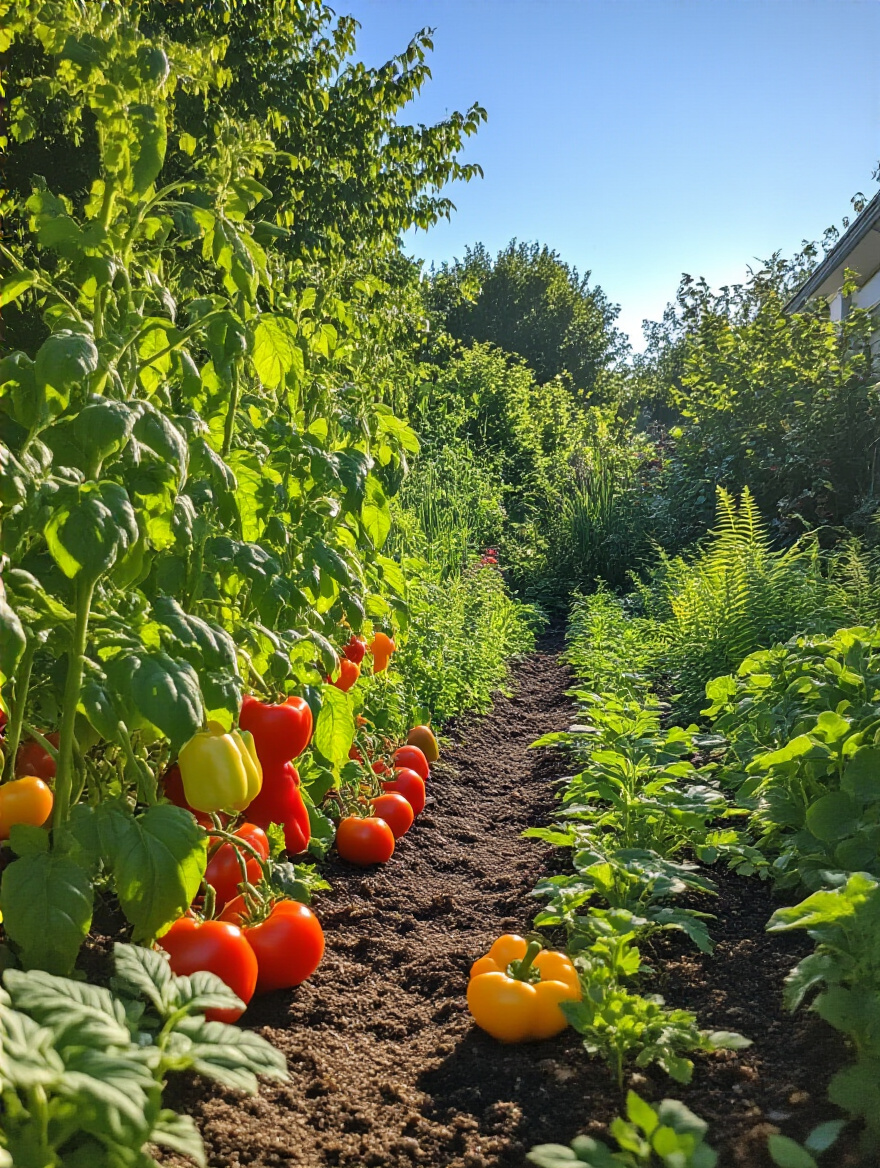
Before you buy a single thing, spend a day just observing. Where does the morning sun gently land? Where is the intense heat of the afternoon? Where is there cool, consistent shade? Sketch it out. This sun map is the most valuable blueprint you will ever have. The common mistake is to fight the light you have. The true path to a serene garden is to work with it. Place sun-worshipping herbs in the hot spots and delicate, shade-loving ferns in the tranquil corners. It sounds obvious, but almost everyone gets it wrong. When you give a plant the exact light it craves, it will radiate vitality with almost no effort from you.
As your plants soak up that glorious sun, your next step is ensuring they have the moisture they need to truly flourish, using one of nature’s most perfect gifts.
Can we just talk about mulch for a moment? It’s the unsung hero of the sanctuary garden. Most people see it as just a decorative topping, a finishing touch. But its true purpose is so much deeper. A thick layer of organic mulch is like a comforting blanket for your soil. It locks in moisture, keeps the roots cool and calm, and suppresses the frantic energy of weeds.
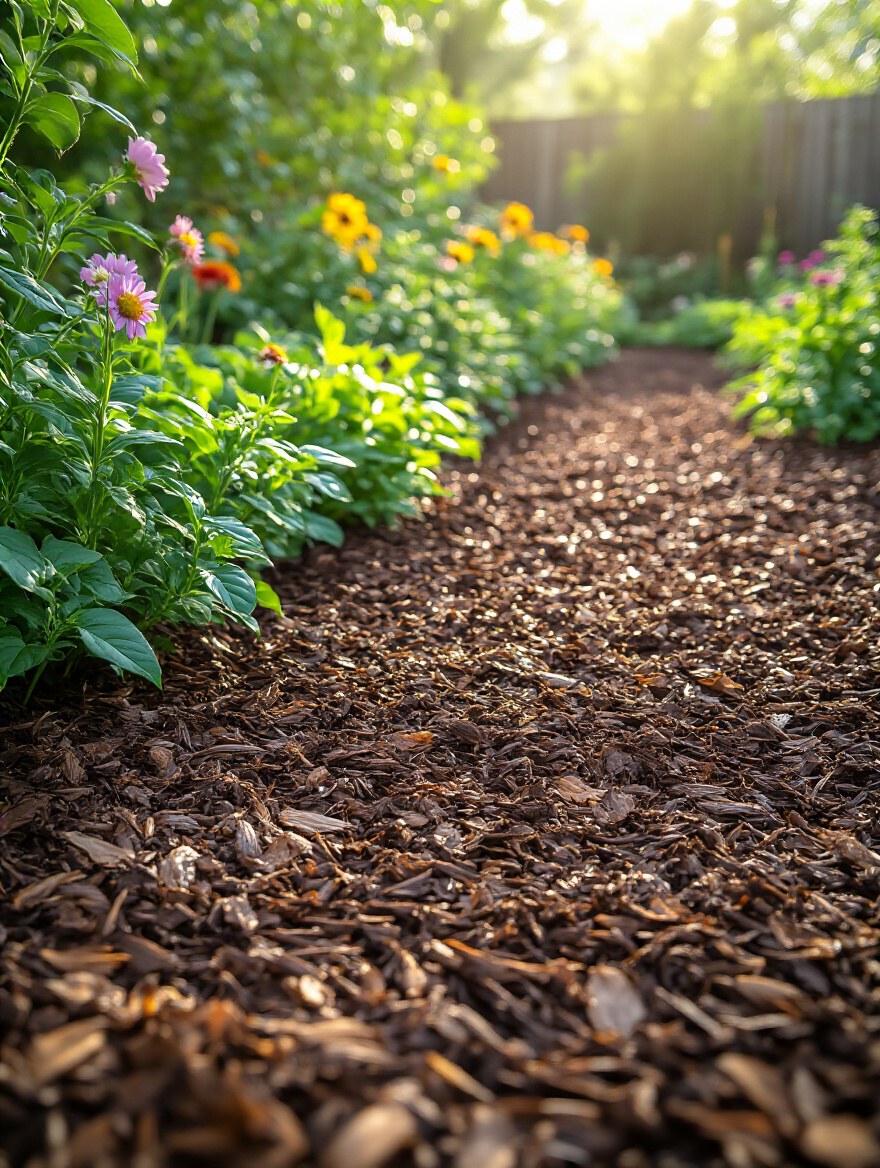
Forget buying bags of dyed wood chips from the hardware store. That’s just noise. You can almost always source the best mulch for free. Call local arborists—they often have piles of wood chips they are desperate to get rid of and will deliver them to your driveway. This isn’t just any mulch; it’s alive, full of microorganisms that will enrich your soil as it breaks down. You can also use your own fallen leaves or grass clippings. It’s a beautiful, circular system. By using what’s freely available, you’re creating a garden that is not only low-water and low-maintenance but is in true harmony with its environment.
Now that we’ve grounded our green spaces, let’s turn our attention to the hard surfaces, transforming them from overlooked to unforgettable.
A bare concrete patio can feel cold, utilitarian, and forgotten. It drains the energy from a space. The common solution is to either live with it or spend a fortune tearing it out. But there’s a much more elegant solution: staining. It’s a way to infuse that cold surface with warmth, color, and a sense of artistry.
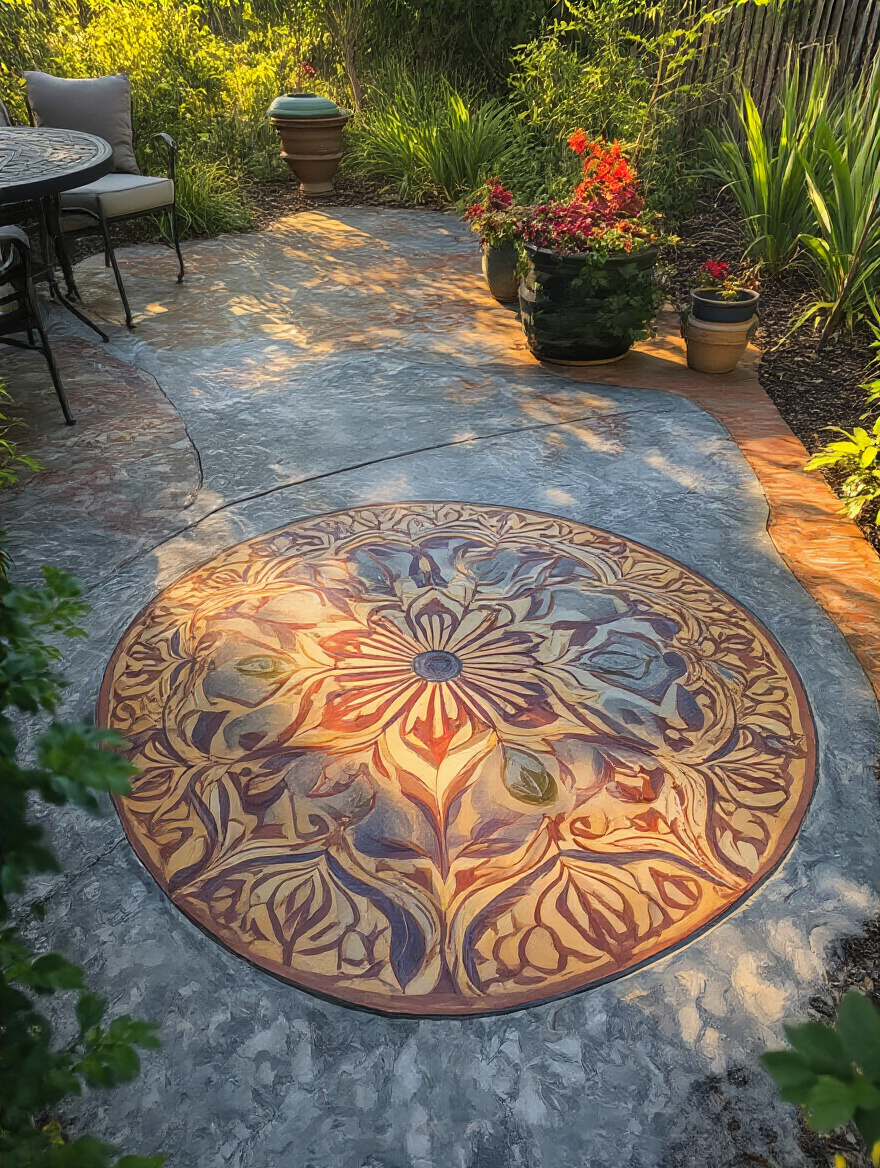
The BS is that this is a huge, complicated job for professionals only. The secret is that with a little patience, you can achieve a look that feels more bespoke and luxurious than expensive pavers. The key is in the prep work. You absolutely cannot cut corners here. You must clean the concrete meticulously, as the stain is translucent and will reveal every flaw. But that’s also its beauty. It works with the history of the surface, creating a layered, marbled effect that feels ancient and earthy. Choose a water-based stain for a soft, watercolor look, and seal it well. For less than a couple hundred dollars, you can create a foundation for your outdoor lounge that looks and feels like it belongs to a Tuscan villa.
This is where your sanctuary truly comes alive. Eco-smart landscaping is about co-creation with nature. It’s about choosing plants and methods that are not only beautiful but are inherently low-stress, both for you and for the planet. This isn’t about wrestling nature into submission; it’s about inviting it in.
Forget a rigid row of matching terracotta pots. A truly soulful garden finds beauty in the unexpected. Creating container gardens from repurposed items is less about saving money and more about infusing your space with personality and story. An old metal washtub, a forgotten colander, a wooden crate—each holds a history that adds a layer of richness to your design.
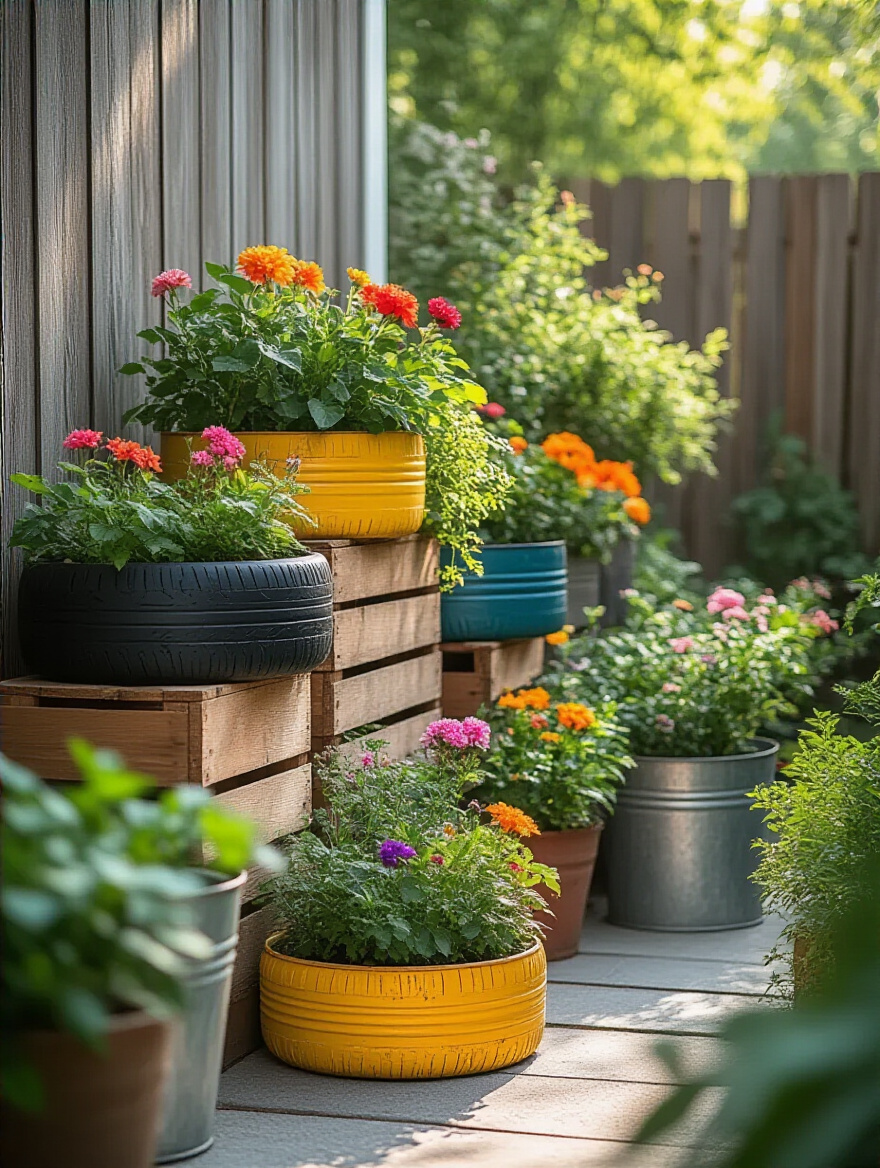
People get this wrong by just throwing dirt in an old boot and calling it a day. That’s a gimmick, not design. The secret to making this look chic and intentional, rather than junky, is twofold. First, drainage is non-negotiable. Drill holes. Lots of them. Nothing dies a sadder death than a plant sitting in stagnant water. Second, think in groupings. A single, oddball container can look lost. But a curated collection of three or five planters made from similar materials—like various metal tins or different wooden boxes—creates a cohesive, artful statement.
As you begin to see the potential in everyday objects, you’ll find your next source of free, vibrant life right in your own kitchen.
There is something profoundly satisfying and grounding about the cycle of life. Regrowing edibles from kitchen scraps is a perfect example of this. It’s the ultimate expression of sustainable living, turning what would be waste into vibrant, nourishing life. Placing the root end of a bunch of green onions in a glass of water on your windowsill and watching it sprout new green shoots is a small miracle that connects you back to the source of your food.
This isn’t just a cute trick for kids. This is about abundance. The bottom of a head of celery, the base of a romaine heart, a clove of garlic—all of these can be coaxed into producing again. You can start them in water and then move them to a pot. This creates a small, continuous harvest of fresh herbs and greens right at your back door. It’s a shortcut to flavor and freshness that reminds you that nature is endlessly generous. There’s nothing more luxurious than snipping your own fresh greens for a salad, grown from the memory of a previous meal.
This practice of working with what is naturally available extends beautifully to choosing the main plants for your garden beds.
I once designed a garden for a client who insisted on having an English cottage garden in the middle of the Arizona desert. It was a constant, expensive, and stressful battle against nature. I learned a vital lesson: the most serene and beautiful gardens are those that surrender to their surroundings. This is the wisdom of using native plants. These are the plants that belong where you live, that are already adapted to your soil, your rainfall, and your climate.

The common misconception is that native plants are just “weeds” or aren’t as beautiful as exotic ornamentals. This could not be further from the truth. The key is to research the stunning variety of native flowers, grasses, and shrubs that thrive in your specific region. Once established, they require very little from you—less water, no fertilizer, no fuss. They live in peaceful harmony with the local ecosystem, and in return, they will reward you by attracting beautiful birds and butterflies to your sanctuary. It’s the ultimate shortcut to a garden that feels established, soulful, and truly alive.
And to care for these plants, you can capture the purest water of all, directly from the sky.
There is something so deeply calming about the sound of rain. Collecting it is an act of reverence. A simple rain barrel connected to your downspout isn’t just a “budget tip”; it’s a way of partnering with nature. You’re capturing a precious resource that is perfectly pH-balanced and free of the chemicals found in municipal tap water. Your plants will feel the difference.
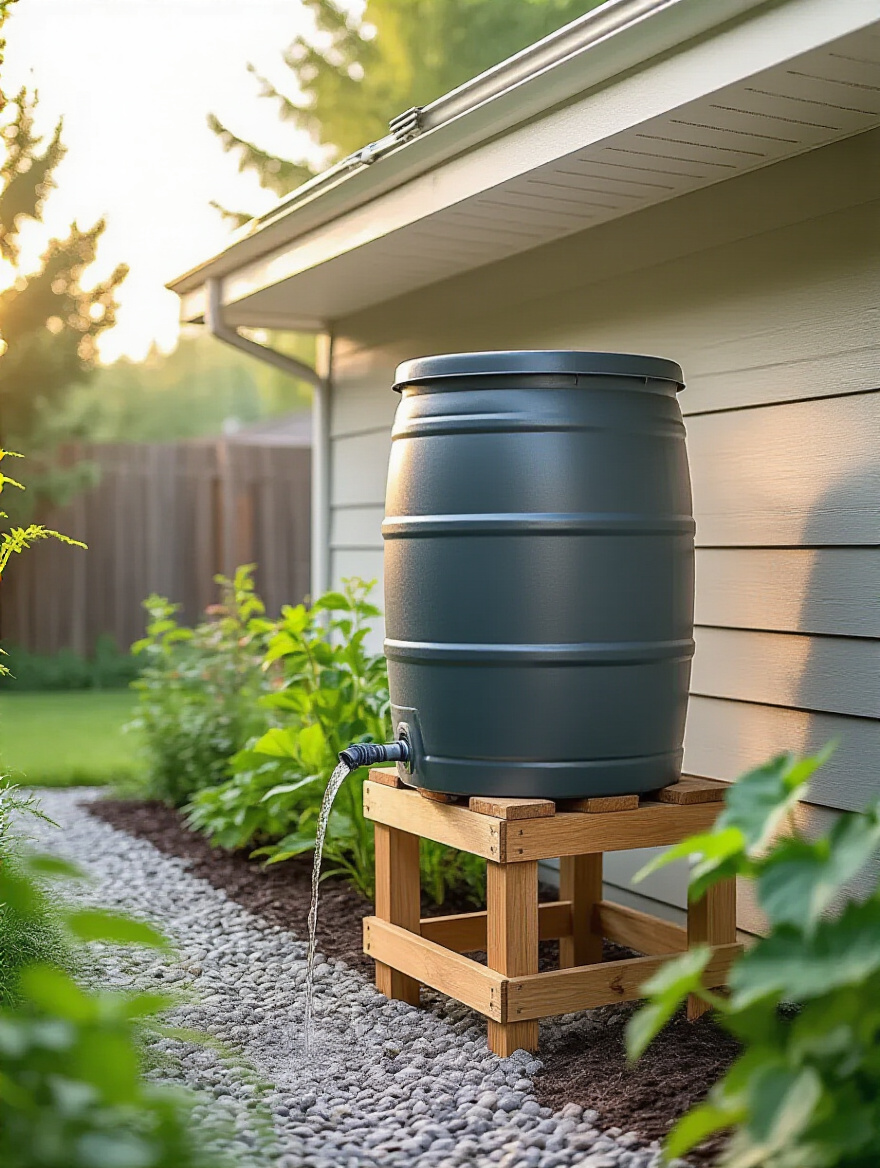
People often get hung up on the aesthetics, picturing a big ugly plastic barrel. But this is an opportunity for beauty. You can find stylish, modern-looking barrels, or you can enclose a simple food-grade drum in a handsome wooden frame. I once saw a client paint hers with a beautiful trailing vine motif that turned it into a piece of garden art. What matters is that you have a screen to keep mosquitos and debris out and a spigot at the bottom for easy access. Using rainwater to tend your garden feels like offering your plants a drink of pure, living water.
With this water, you can then perform one of the oldest and most magical acts of gardening: creating new life from what you already have.
There’s a special kind of magic in taking a simple cutting from a plant you love and watching it grow roots, becoming a new, whole plant. It feels like cheating, but it’s one of the oldest forms of gardening. It allows you to fill your sanctuary with more of the plants that bring you joy—that fragrant rosemary, that lush hydrangea—for absolutely no cost. It’s the definition of abundance.
The BS here is that you need a laboratory and a degree in botany. Not true. Many plants, especially soft-stemmed herbs and shrubs, are eager to root. All you need is a clean cut below a leaf node, a bit of rooting hormone (my secret weapon that dramatically increases success), and a pot of simple, moist soil. The trick I wish I’d known earlier is to create a tiny greenhouse for your cuttings by covering the pot with a clear plastic bag. This high humidity encourages roots to form much faster. Don’t be discouraged if a few don’t make it. Just take more cuttings than you think you’ll need. It’s a numbers game, and the reward is a garden full of plants that are literally extensions of the ones you already cherish.
As your collection of propagated plants grows, you can give their new homes a beautiful and grounding border using materials from the earth itself.
A garden bed without a defined edge can feel messy and unfinished. The energy just spills out. But you don’t need to buy expensive metal or plastic edging to create that sense of gentle containment. Using found rocks or fallen logs is a beautiful way to bring a raw, elemental texture to your garden design. It feels more organic, more integrated into the landscape.
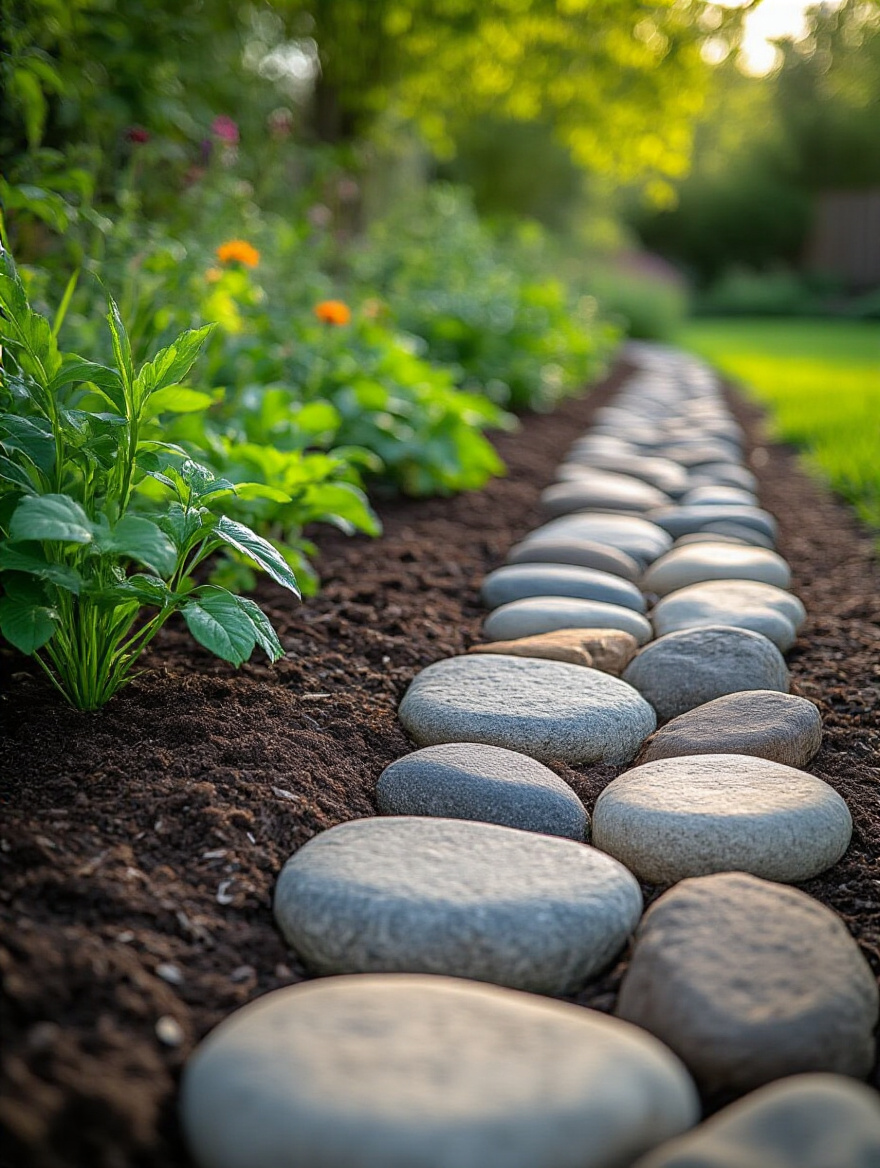
I once watched a client spend a weekend meticulously arranging stones he had collected from a corner of his property to create a border for his new herb garden. The result was breathtakingly authentic. He didn’t just build a wall; he wove a piece of his land’s own story into his design. That’s the magic. The shortcut is to dig a shallow trench first. Nestling the rocks or logs slightly into the earth gives them a sense of permanence and stability, making them look like they’ve been there forever.
This is where your unique energy truly gets to shine. DIY isn’t about being cheap; it’s about crafting one-of-a-kind pieces that you can’t buy in a store. It’s about upcycling things with a past to give your sanctuary a soul. Every piece will tell a story.
Let’s be honest: good outdoor furniture is absurdly expensive. And most of it is soulless and generic. Building your own seating from pallet wood is an act of creative rebellion. It allows you to design a piece that fits your space and your vision perfectly, whether it’s a sprawling daybed for napping or a cozy L-shaped sofa for entertaining.
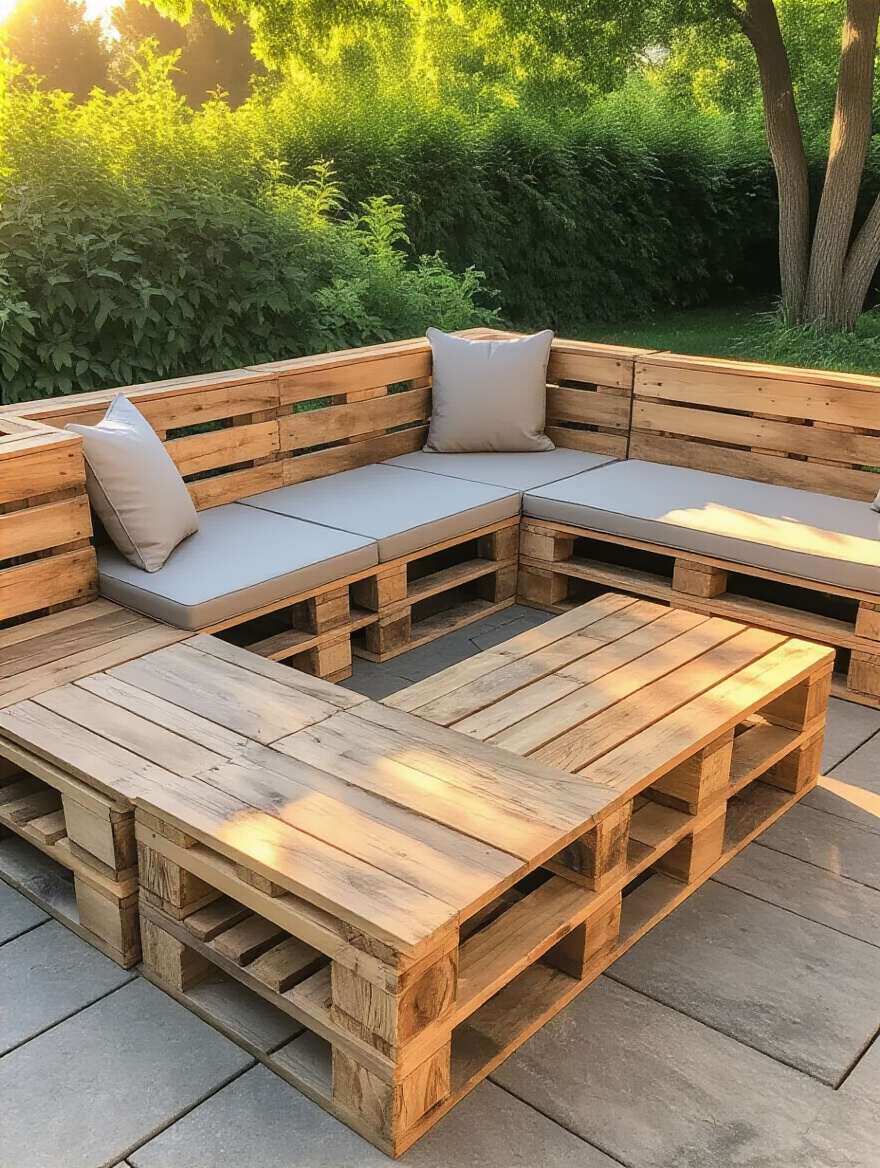
Now, everyone thinks they can just slap a few pallets together. That’s how you end up with something that looks like it belongs in a junkyard. The real work—the part that makes it look luxurious—is in the finishing. You must, must, must use pallets stamped “HT” for “heat-treated,” never “MB” for chemically-treated. Then you have to take the time to disassemble them, sand every single piece until it’s silky smooth, and seal it with a high-quality outdoor varnish. It’s labor, yes, but it’s a labor of love. When you top it with plush, custom cushions, you’ll have a piece of bespoke furniture that feels infinitely more special than anything you could buy.
With your custom seating ready, the next step is to create a focal point for warmth and connection.
A fire pit is the heart of an outdoor sanctuary. It’s where people gather, where stories are told, and where you can stare into the flames and feel a deep sense of peace. People think they need an expensive, custom-built stone fireplace. You don’t. A simple cinder block fire pit can be incredibly chic and modern.
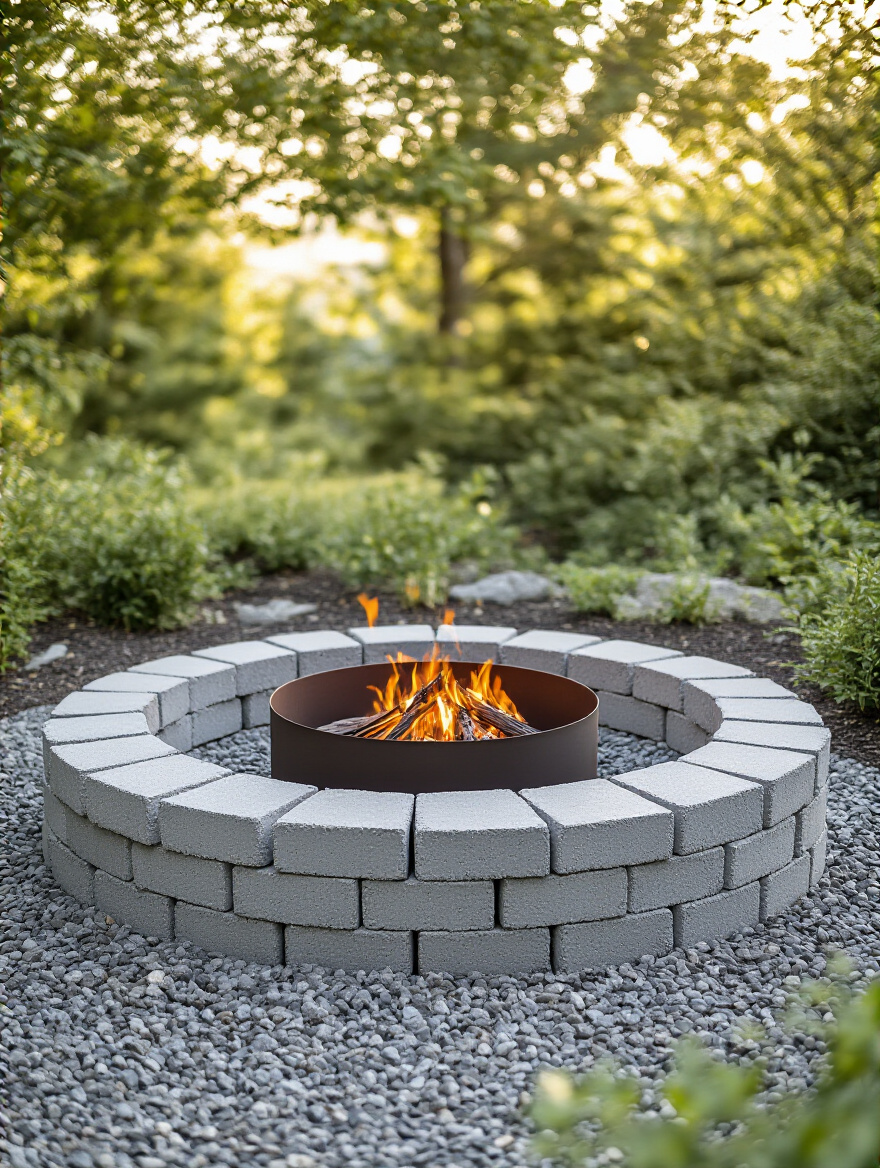
The key is to see the cinder blocks not as the final product, but as the strong, affordable bones of your design. You can arrange them in a square or circle, and then comes the beautiful part: you can finish them. Stucco them for a smooth, Mediterranean look. Cap them with slate for a sophisticated ledge to rest a drink on. Paint them a dramatic charcoal grey. And here’s the one thing you can’t skip: you need a steel fire ring insert. This protects the blocks from cracking under the intense heat and makes the entire structure safer and more durable. It’s the one small investment that elevates the whole project from a DIY experiment to a lasting feature.
Once you have your gathering spot, you can bring even more life into your space by looking up.
When you run out of floor space, the only way to go is up. A vertical garden is a stunning way to create a wall of lush, living green. It can provide privacy, soften a hard wall, and offer a bounty of fresh herbs and lettuces right at your fingertips. And you don’t need an expensive, complicated kit to do it.
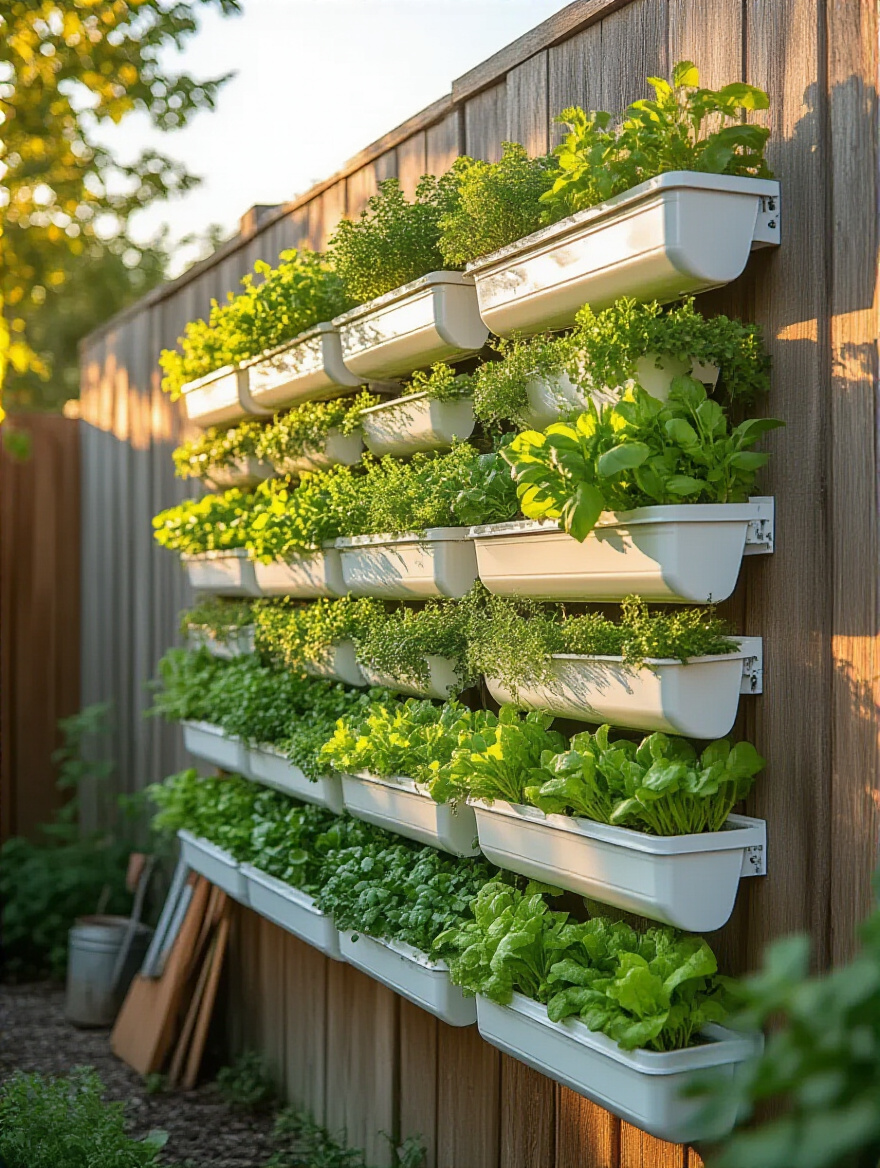
Old rain gutters are perfect for this. Their long, shallow shape is ideal for growing things like leafy greens, strawberries, and herbs. The trick to making this look intentional and not like a pile of leftover construction materials is in the execution. Mount them in a clean, repeating pattern. Paint them all a single, unifying color—a deep charcoal, a crisp white, or a vibrant pop of color against a neutral wall. And you must drill plenty of drainage holes. It’s the most common mistake and the one that will doom your vertical garden before it even begins.
From the walls to the ground, the spirit of repurposing can continue with planters born from the most humble of origins.
A beautiful planter can be a work of art. It can also be a ridiculously expensive piece of pottery. But some of the most charming and personal planters I’ve ever seen were created from the simplest household waste. Large tin cans, plastic milk jugs, old laundry baskets—these are your blank canvases.

The difference between charming and trashy is, again, in the details. A collection of tin cans, all painted the same matte black and planted with bright green succulents, looks incredibly sophisticated. An old olive oil can with its beautiful lithography is a perfect vessel for a rosemary plant. The key is to commit. Clean the item thoroughly, ensure there is drainage (always!), and think about how its shape and material can complement the plant you put inside it. It’s about seeing the potential for beauty in the mundane.
As your plants begin to climb, you can give them an elegant structure to cling to, created from nature’s own discards.
A climbing plant needs something to aspire to. A plastic trellis from a big-box store feels lifeless and clumsy. But a trellis crafted from foraged branches has an inherent grace and beauty. It’s a functional sculpture that feels like it grew right there in your garden.
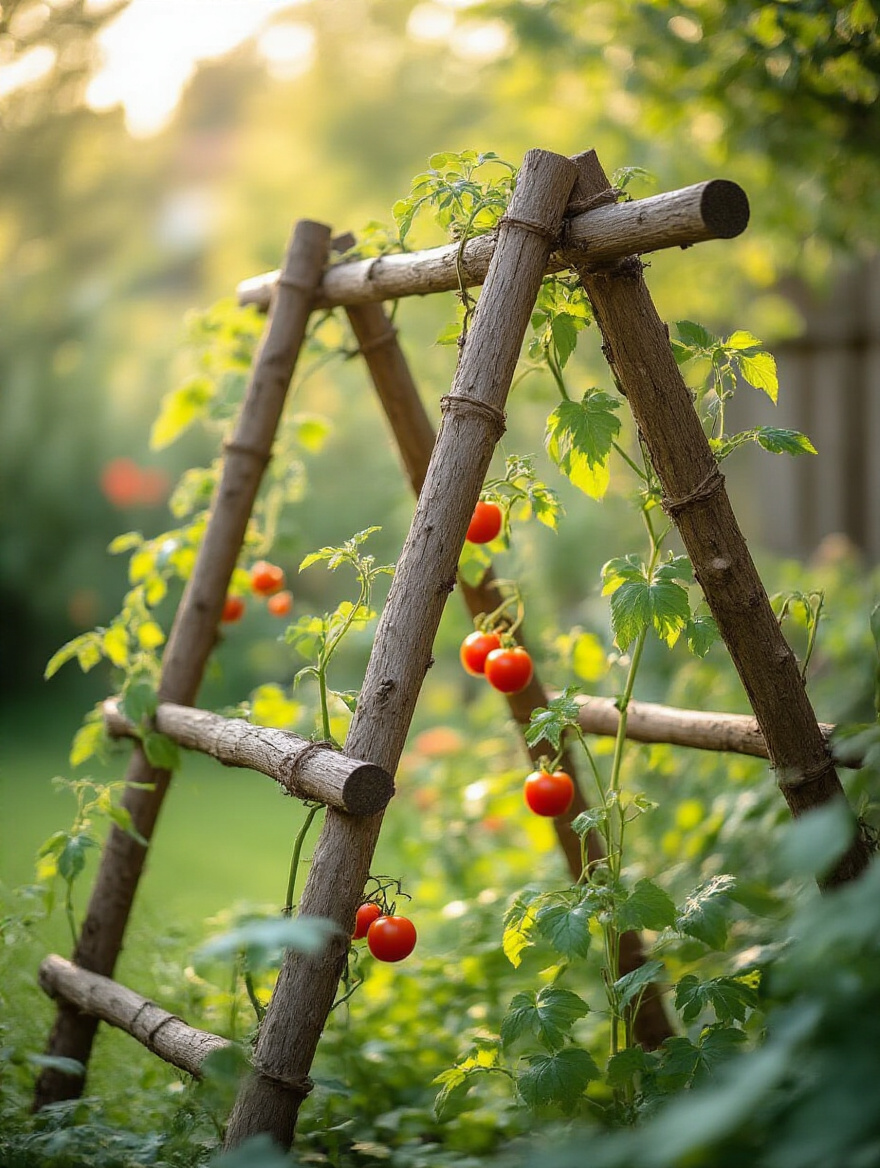
This is a beautiful project for a quiet afternoon. Gather sturdy, interesting branches from your own yard or a place where it’s permitted. Look for branches with natural forks and curves; these are perfect handholds for a climbing vine. You can lash them together into a teepee shape with natural jute twine or create a flat, ladder-like structure to lean against a wall. The shortcut I love is to “cure” fresh branches for a few weeks to let them dry out completely. This prevents them from warping after you’ve built your structure. It’s a small step of patience that ensures your beautiful creation will last.
To move between these beautiful vignettes, you’ll want a pathway that feels just as grounded and natural.
A pathway in a garden does more than just keep your feet dry. It guides your journey. It directs your gaze. It sets a pace, encouraging you to slow down and experience the space. Using recycled materials like old bricks or simple pea gravel to create these paths is not only resourceful but adds a sense of history and texture.
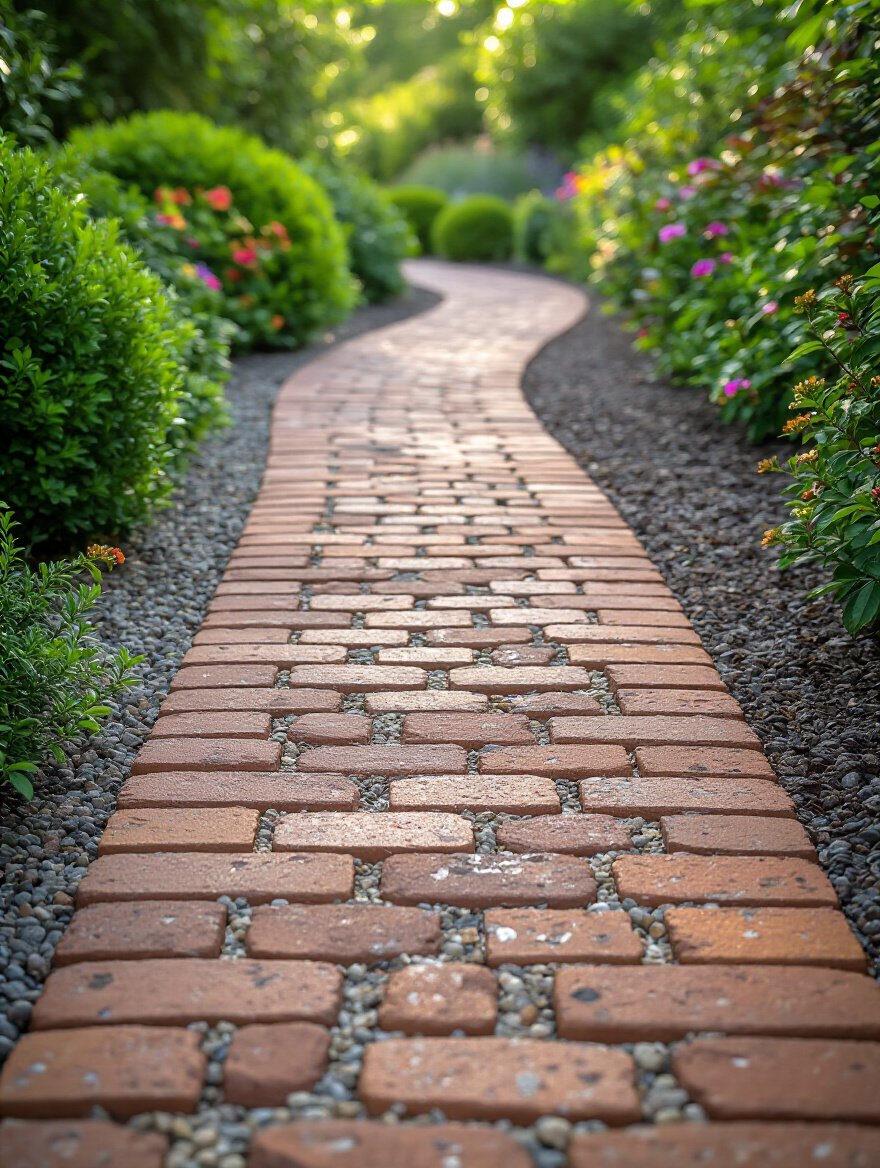
The one thing everyone gets wrong with paths is skimping on the foundation. This is what leads to wobbly bricks and gravel that scatters everywhere. It’s the unseen work that matters most. You have to excavate a few inches, lay down a weed barrier, and put down a solid base of compacted crushed stone. It’s not the glamorous part, but it’s the secret to a path that feels solid and permanent underfoot. I love the Japanese tradition of “tobi-ishi,” or spaced stepping stones. A path doesn’t have to be a solid band; it can be a series of intentional invitations to take the next step.
Your sanctuary should nurture you day and night. This is about creating an atmosphere. It’s about layering light, sound, and comfort to transform your backyard into an enchanting retreat perfect for quiet solitude or warm gatherings. This is where we appeal directly to the senses.
The goal of nighttime lighting isn’t to blast your yard with light like a stadium. It’s to create mystery, safety, and a soft, warm glow. The problem is that most people think solar lights are all cheap, tacky, and cast a cold, bluish light. And for a long time, they were right.
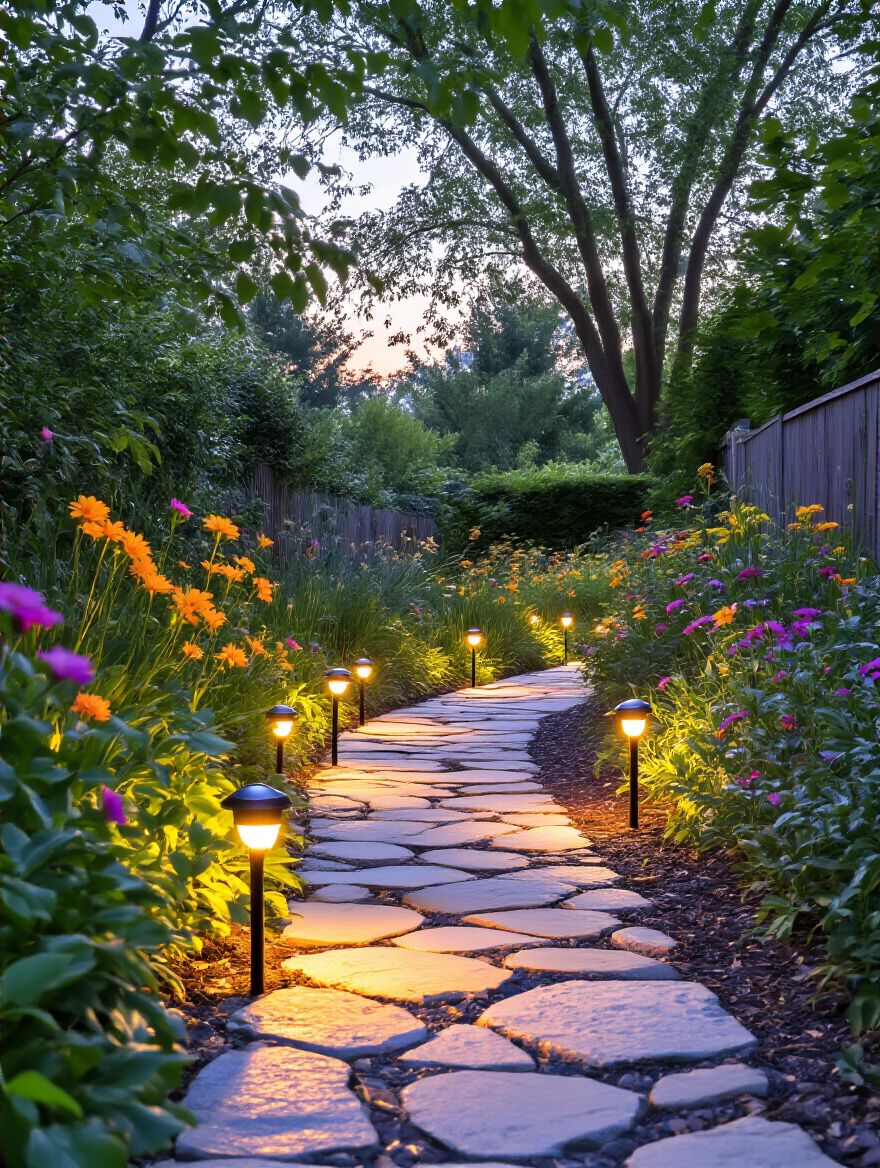
The secret is to be selective. Today, you can find beautiful, high-quality solar lights that cast a warm, ambient glow. Look for ones with glass, not plastic, casings, and check the “lumens” and “temperature” ratings—you want lower lumens for ambiance and a warm temperature (around 2700K). Instead of lining them up like a runway, stagger them along a path, tucking them among plants so they cast intriguing shadows. Use them to uplight a beautiful tree or skim the surface of a textured wall. Used thoughtfully, they bring a gentle, living light to the garden that respects the darkness and makes your evenings feel magical.
Now that the ground is lit, let’s create a celestial canopy overhead.
There is nothing—and I mean nothing—that transforms an outdoor space more instantly and dramatically than a canopy of string lights. They are pure magic. They create an instant sense of celebration and intimacy, defining an outdoor room with a ceiling of soft, glittering stars. They make any evening feel like a special occasion.
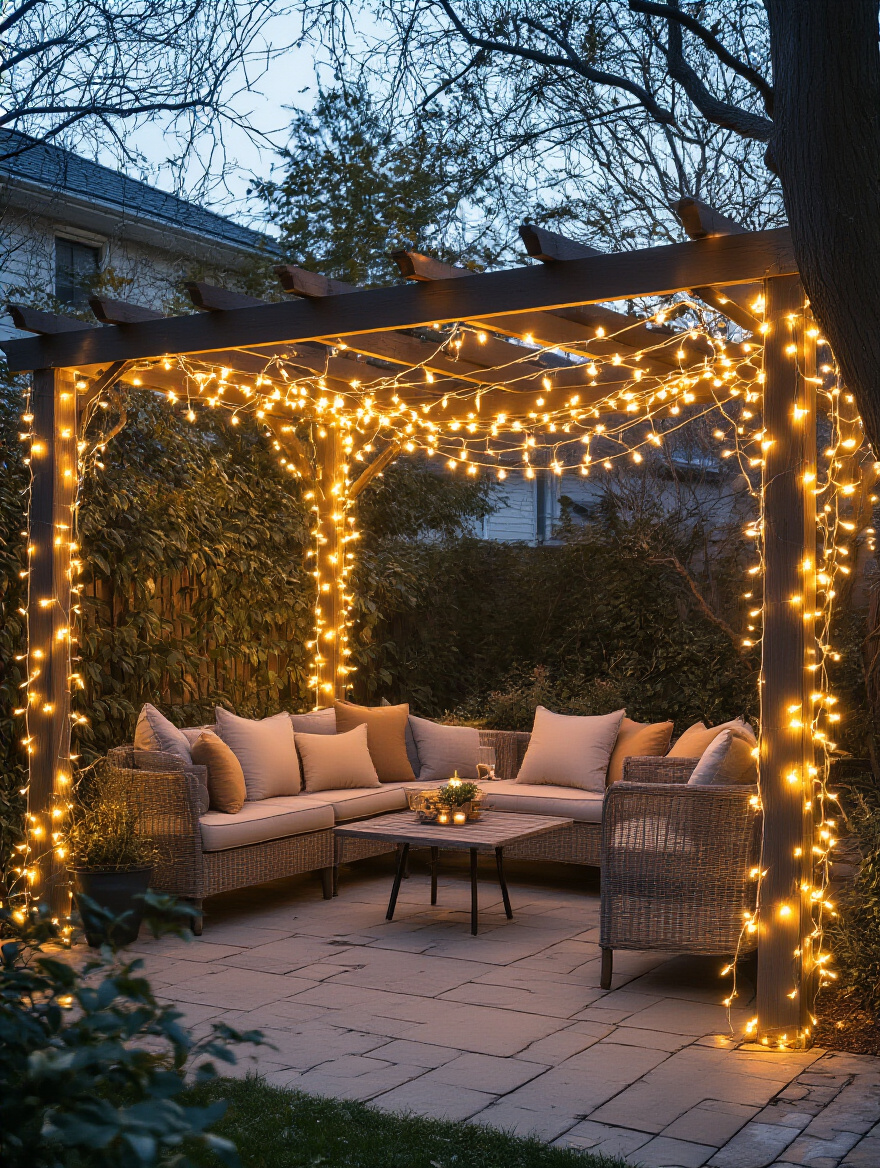
The common mistake is just draping one sad little strand from a hook. To get that luxurious, restaurant-patio feeling, you need to commit. Use multiple strands. Crisscross them in a dense pattern to create a true canopy effect. My favorite shortcut for places without trees or a pergola is to make your own poles. You can set simple wooden posts or metal conduit pipes in buckets of concrete, paint them black, and use them as anchors. It’s an easy and affordable way to hang lights anywhere, creating an enchanting floating room in the middle of your yard. And always, always choose warm, dimmable LED lights for the perfect glow.
Beneath this beautiful glow, you can add layers of personality with pieces that have a past.
A space filled only with brand-new things can feel sterile. To give your sanctuary a soul, you need pieces with a story. Thrift stores are absolute treasure troves for unique outdoor decor. You’re not just looking for “old stuff”; you’re hunting for objects with beautiful form, interesting texture, and a sense of history.
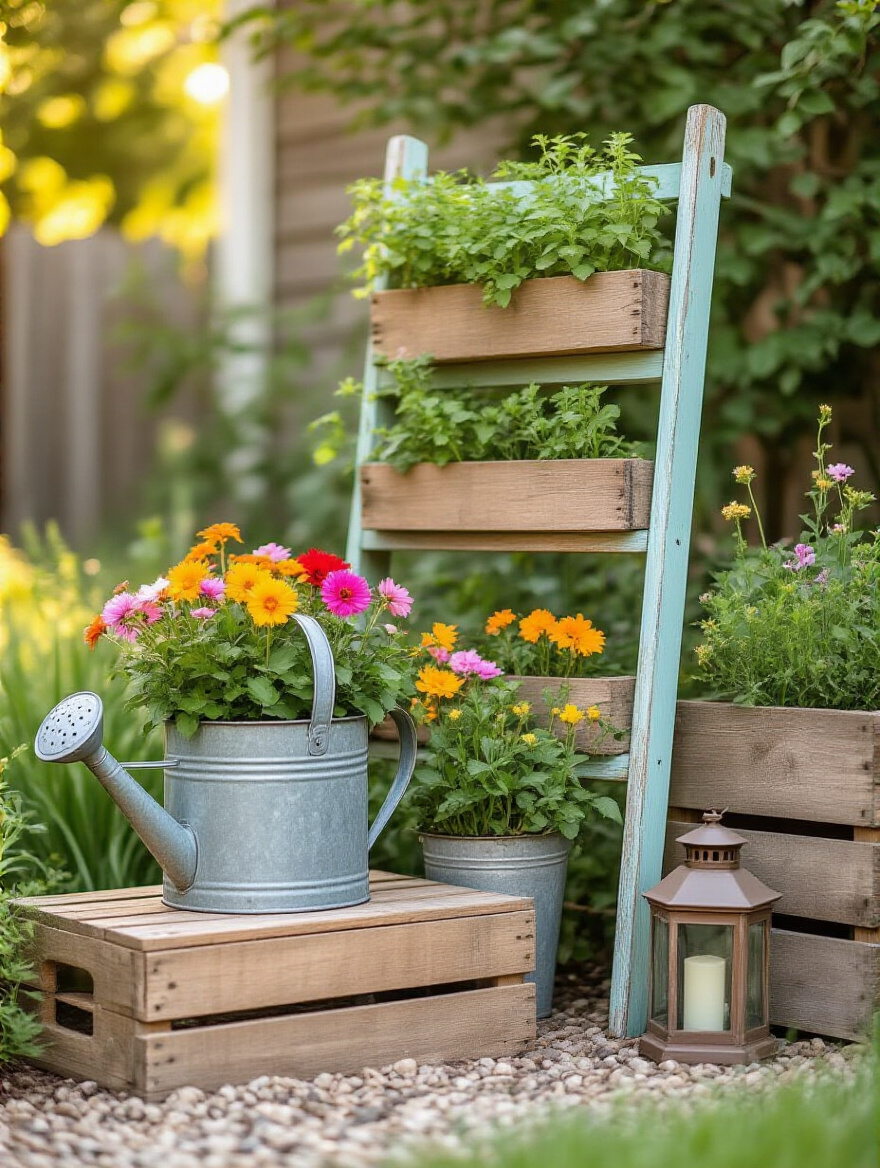
Forget looking in the “garden” section. Look for old metal watering cans, mismatched china plates to hang on a fence, ornate picture frames to place around a plant, or even a beautiful old chair that’s past sitting on but perfect for holding a pot of trailing ivy. The trick is to have a vision. Before you go, think about the feeling you want to create—rustic, bohemian, minimalist—and look for pieces that speak to that. A quick coat of clear, matte spray sealant is my go-to trick to protect metal or wood items from the elements without making them look shiny and new.
Now, let’s add the most soothing element of all to our sensory experience.
The sound of trickling water is the ultimate natural stress reliever. It instantly calms the nervous system and masks distracting neighborhood noise. You don’t need an expensive custom fountain. You can create a beautiful, bubbling water feature yourself using a few stacked pots and a small submersible pump.
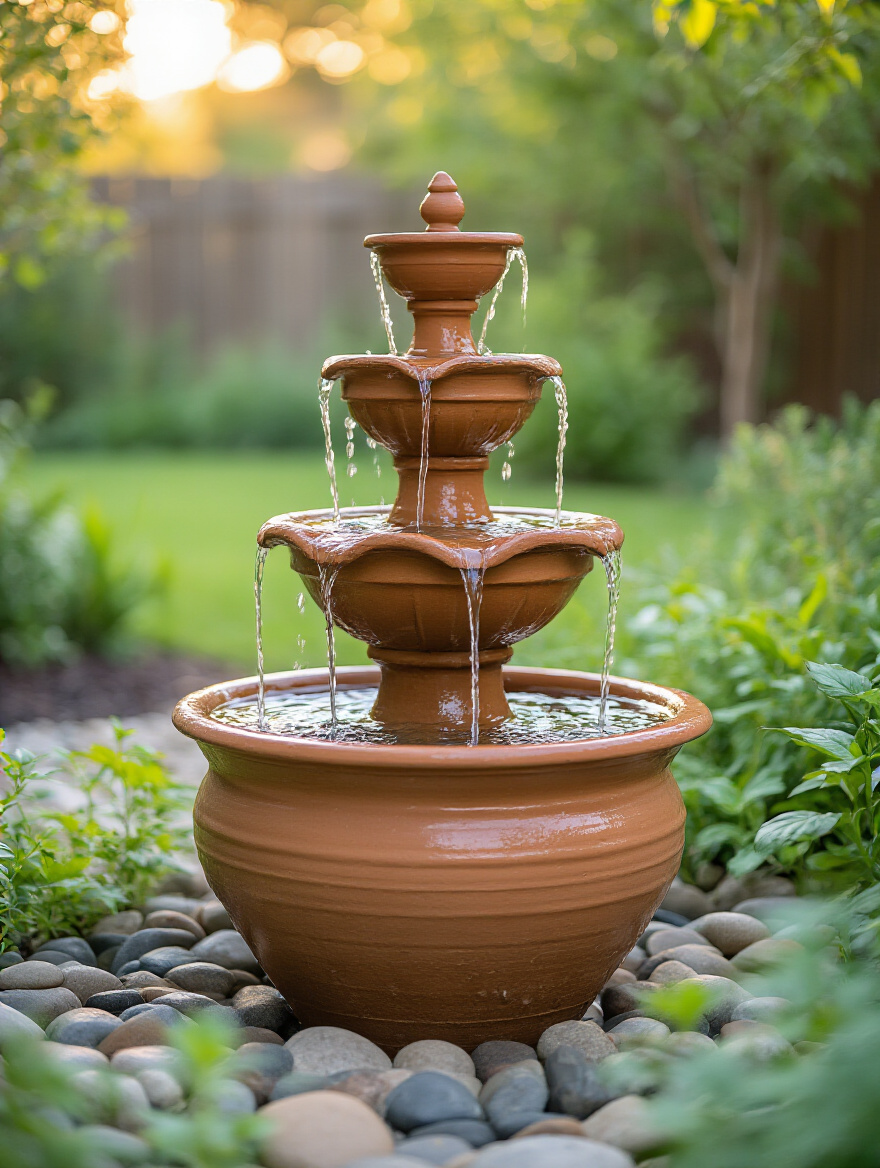
The secret to making this look chic and not like a high school science project is to choose your pots carefully. A collection of three terracotta pots in varying sizes, or even beautiful ceramic bowls, creates an elegant cascade. The pump, which you can get for under $30, is hidden in the bottom pot (your reservoir), and a clear tube runs up discreetly through the drainage holes to the top. I love to fill the bottom reservoir with smooth river stones to hide the pump completely. It’s a small detail that makes the entire feature feel more natural and integrated.
With sound, light, and comfort in place, you can add an element of shared experience and create lasting memories.
Imagine watching a classic film under the actual stars. It’s an unforgettable experience. Creating a backyard cinema is surprisingly simple and transforms your sanctuary into a destination for connection and fun. It’s not about replicating a commercial theater; it’s about the charm of the experience itself.
All you really need is a simple, portable projector (they are incredibly affordable now) and a smooth, white surface. A tautly hung white sheet is classic and beautiful. The BS part is that a projector’s built-in speaker is good enough. It never is. The shortcut to a great experience is to connect a decent Bluetooth speaker for clear, rich sound. Pile up blankets, cushions, and low-slung chairs, and light some citronella candles. It’s an experience that feels infinitely more special and memorable than sitting on the sofa.
Finally, let’s create a space within our sanctuary that is dedicated to the wonder and creativity of the littlest members of our family.
For those with children, a sanctuary must also be a place of safe, imaginative play. A plastic turtle sandbox from the store is an eyesore that screams “toy.” But a natural sandpit, built right into the landscape, can be a beautiful and engaging feature that encourages creativity.
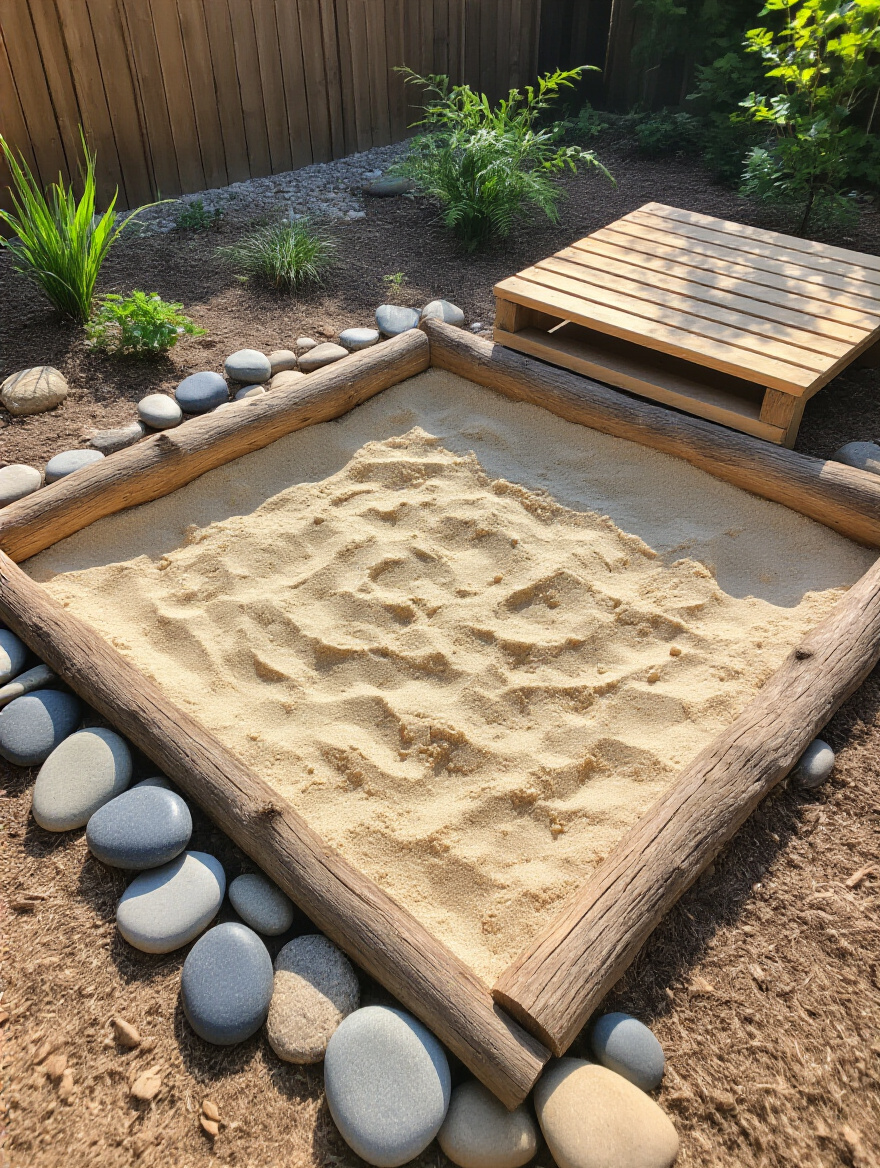
You can create a border with smooth, repurposed logs or a low wall of river stones that harmonizes with your garden beds. The crucial, can’t-skip step is to excavate the area and lay down a permeable landscape fabric before you add the sand. This allows water to drain out (preventing a muddy swamp) but stops weeds from growing up through it. It’s the invisible work that ensures the space is low-maintenance and enjoyable for years. Always use clean, washed play sand, and create a simple cover to keep it clean. This dedicated space for sensory play becomes a beautiful, functional part of the overall sanctuary design.
Creating a sanctuary is not an act of spending; it’s an act of listening. It’s about listening to your space—to the path of the sun, to the whisper of the wind—and listening to yourself—to your own need for quiet, for connection, for beauty. As you can see, a deeply restorative outdoor space is born from thoughtfulness, creativity, and a partnership with nature, not from a hefty price tag.
The true luxury is the feeling you get when you step into a space that you have personally curated, infused with your own energy, and designed to nurture your well-being. The value lies in the slow, peaceful mornings with a cup of tea, the laughter-filled evenings under a canopy of lights, and the profound sense of peace that comes from having a place to truly call your own. Your affordable, authentic oasis is waiting for you. Just begin.